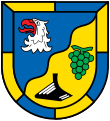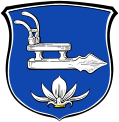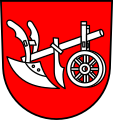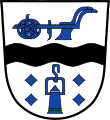Ploughshare
The ploughshare ( which , rarely that ) is the cutting edge of the plow . The plow body in its entirety is also imprecisely referred to as a share . One speaks of multi-blade plows, but actually means plows with several bodies.
With the reinforcement of the ploughshare with iron , it became possible to work on heavier soils .
Coat of arms with ploughshare
The ploughshare is a common figure in heraldry and is represented in different numbers (one to three are common) and positions in the coat of arms. Pointing down is standard, pointing up is reported as fallen . The entire plow is strongly stylized as a work tool and can also be found in the coat of arms ; Details such as wheel or six must be reported.
The frequent use in coats of arms testifies to the importance and the connection between agriculture and the people of the region. An old superstition was based on the fact that a ploughshare could ward off evil spells. In spring, fields or even district boundaries were plowed over to keep evil spirits away. For this reason it is originally a heraldic symbol of luck.
Ploughshare in the Erding coat of arms
Plowshares in the Tunau coat of arms
Ploughshare in the coat of arms of the city of Leuna
Ploughshare in the Erlbach coat of arms
Ploughshare in the coat of arms of Reichenbach an der Fils
Ploughshare in the coat of arms of the municipality of Monsheim
Plow in the coat of arms of the Gammertingen district of Feldhausen
Pfug in the coat of arms of Kirchlinteln
Plow in the coat of arms of Müllendorf
Plow in Neuler's coat of arms
Plow in the coat of arms of Schwarzach near Nabburg
See also
- Swords to plowshares
- Coat of arms of Stephan Ackermann , Bishop of Trier
- The legend of the golden plow iron
Web links
Individual evidence
- ^ Rudolf Schubert , Werner Hilbig, Stefan Klotz: Identification book of the plant societies in Germany. Spectrum, Akademischer Verlag, Heidelberg et al. 2001, ISBN 3-8274-0915-2 .
- ↑ http://www.bistum-trier.de/bistum-bischof/bischof/insignienamtszeichenackermann/














